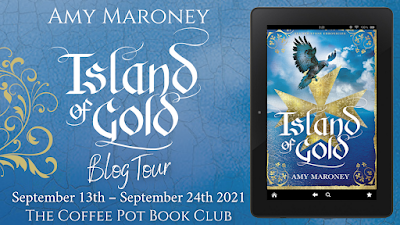Thank you for hosting me on your blog, Helen!
[my pleasure Amy!]
Island of Gold, the first book in my Sea and Stone Chronicles series, takes place on and around the islands of Rhodes and Cyprus during the medieval rule of the Knights Hospitaller. The novel was inspired by a three-week visit to the island of Rhodes with my family ten years ago. During that visit, I marveled at the ancient temples and crumbling statues of goddesses that existed alongside massive stone walls and forts built by the Knights Hospitaller. Inside the rebuilt palace of the knights, I peeked into dim corridors where stone tablets carved with European knights’ coats-of-arms leaned haphazardly against the walls.
Staring at those forgotten slabs of stone, I found myself wondering who the knights had been, where they had come from, and how they had died. I imagined them on horseback, clad in metal armor, heading out from the thick walls of Rhodes Town to protect all Christendom from Muslim forces in the East. Once I delved into the research for Island of Gold, I learned how wrong my imaginings had been. The knights’ power lay not on land, but in the seas. Their naval superiority was what kept their attackers at bay. At their core, I discovered, the Knights Hospitaller were pirates.
 |
Breydenbach’s Rhodes Town woodcut, 1486,
public domain image from Wikimedia commons |
The Order of St. John of the Knights Hospitaller began in Jerusalem during the 1100s as a hospice for sick pilgrims. After gaining papal protection a century later, it expanded its operations to become both a religious and military organization, defending the crusader states in the Holy Land. As Muslims took over the crusader states, the Knights Hospitaller withdrew first to the Greek island of Rhodes and—after their expulsion by the Ottoman Turks in 1522—eventually regrouped in Malta.
The organization’s lifeblood was in Western Europe. Wealthy donors infused the Hospitallers with land, rights and revenues; their sons became knights of the Order and travelled to the Holy Land, Rhodes, and Malta to defend Christendom. Each European region or kingdom with ties to the Order was called a ‘tongue.’ France had three tongues: Ile-de-France, Auvergne, and Provence. During the era of Island of Gold, the Grand Master of the Knights Hospitaller was Jacques de Milly, a seasoned knight from Auvergne and a pivotal character in the novel.
 |
Jacques de Milly
public domain image via Wikipedia Commons |
One thing that surprised me in the course of my research was how few knights lived in Rhodes during the mid-fifteenth century. Rhodes Town (the largest community in Rhodes and the headquarters of the Order for two hundred years) housed about three hundred knights at that time. The bulk of their fighting force was made up of mercenaries, some of whom were recruited from overseas, while others known as ‘turcopoles’ were local men conscripted into service.
Most knights were wealthy second or third sons of noble families. Sending a son on a “tour” with the knights was both fashionable and a demonstration of piety. It was not glamorous, though. I found evidence of a young French knight who arrived in Rhodes only to be horrified by the brutality he witnessed. He wrote a letter home begging his parents not to send his younger brother to join him. They ignored his pleas and the boy was sent to Rhodes as a page and later killed.
That poor Frenchman had discovered what I learned in my research: the knights were pirates, like most seafaring societies in the medieval Mediterranean. They raided Muslim villages in Turkey, Syria, and Egypt. They took captives and sold them as slaves (or kept them to build fortifications in Rhodes Town and work their sugar plantations). Mercenaries employed by the Order were allowed to keep much of what they stole. The Order was constantly engaged in negotiations with the Ottoman Turks and the Mamluks (the rulers of Egypt at the time), dealing with exchanges of prisoners and attempts to mitigate violence at sea. But both sides routinely broke their fragile agreements.
 |
Street of the Knights, Rhodes Town.
Unsplash photo |
How did all of this affect Greeks in Rhodes? The knights were feared by the people of Rhodes, but they were also respected. As Christians, Rhodians were terrified of a Muslim takeover of their island, and the knights were a bulwark against that possibility. The knights were a source of employment and occasionally great fortunes. Mercenaries who showed exceptional courage or brought back the best booty were sometimes rewarded with homes and lands. The Order needed Greeks to help them communicate with Turks, Middle Easterners, and Africans. They also relied on the Greeks’ excellent ship-building, sailing, and navigational skills to ensure their naval prowess was unmatched.
Of the dozens of academic papers I studied during the research for Island of Gold, there are some illuminating standouts. One of them discusses the archaeological find of wrecked Renaissance-era ships in the sea between Rhodes and Turkey. At that time, piracy was so commonplace that even merchant ships were outfitted with crossbows and iron or bronze swivel guns. Another paper, by noted Hospitaller scholar Anthony Lutrell, delves into the complex world of piracy around Rhodes and Cyprus during this era. His evidence shows that Catalans were the most successful pirates. A character in Island of Gold is modelled after a real-life Catalan pirate named Baldaia.
Another paper, by scholar Terrance Dugan, shows the discrepancy between an assumption that no one sailed the Mediterranean during winter back then and the reality (based on historical records such as insurance policies) that people actually did. The historical record is full of assertions that shipping was closed during the winter in the medieval Mediterranean. And yet Dugan’s findings show it’s not true. This discovery was helpful when I wrote scenes involving winter seafaring.
I never imagined when I first stepped foot in Rhodes Town a decade ago that I would one day write a novel about the place and its history. But it cast a spell on me that only grew stronger over the years. There was just too much dazzling adventure bottled up in all those layers of history, struggling to be set free. Stories of knights, and pirates, and the ordinary women and men who struggled to prosper in their medieval world. With each book in the Sea and Stone Chronicles, I aim to bring those forgotten voices into the light.
 |
medieval hospital in Rhodes Town
Unsplash photo |
Island of Gold (Sea and Stone Chronicles)
By Amy Maroney
1454. A noble French falconer. A spirited merchant’s daughter. And a fateful decision that changes their destiny forever.
When Cédric is recruited by the Knights Hospitaller to the Greek island of Rhodes, his wife Sophie jumps at the chance to improve their fortunes. After a harrowing journey to Rhodes, Cédric plunges into the world of the knights—while Sophie is tempted by the endless riches that flow into the bustling harbor. But their dazzling new home has a dark side.
Slaves toil endlessly to fortify the city walls, and rumors of a coming attack by the Ottoman Turks swirl in the streets. Desperate to gain favor with the knights and secure his position, Cédric navigates a treacherous world of shadowy alliances. Meanwhile, Sophie secretly engineers a bold plan to keep their children safe. As the trust between them frays, enemies close in—and when disaster strikes the island, the dangers of their new world become terrifyingly real.
With this richly-told story of adventure, treachery, and the redeeming power of love, Amy Maroney brings a mesmerizing and forgotten world to vivid life.
Buy Links:
This novel is available on #KindleUnlimited
Amy Maroney lives in the Pacific Northwest with her family, and spent many years as a writer and editor of nonfiction before turning her hand to historical fiction. When she's not diving down research rabbit holes, she enjoys hiking, dancing, traveling, and reading. Amy is the author of the Miramonde Series, a trilogy about a Renaissance-era female artist and the modern-day scholar on her trail. To receive a free prequel novella to the
Miramonde Series, join Amy's readers' group at
www.amymaroney.com. (Just copy and paste into your browser.)
Social Media Links:












































